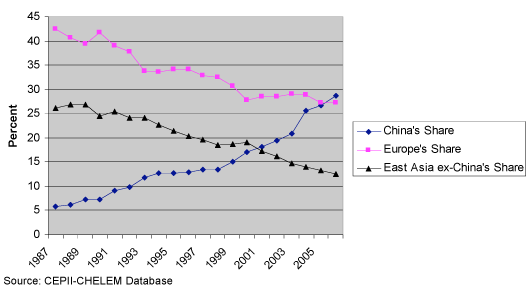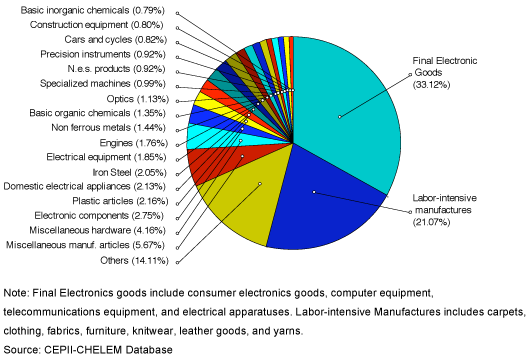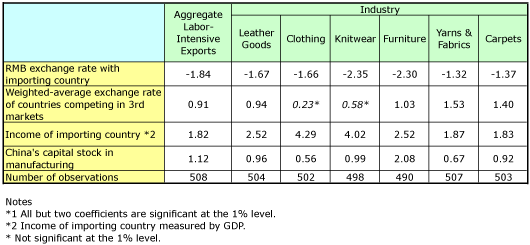The Present state of disequilibrium in China's balance of payments
1) What observations and intuitions prompted you to conduct this research?
We are all interested in China's export juggernaut. China's exports have grown faster than 22% per year between 2005 and the first half of 2008. Its current account surplus exceeded 11% of GDP in 2007, and its capital account surplus approached 3% of GDP, leading many people to argue that China faces a fundamental disequilibrium in its balance of payments and that it needs to let the RMB appreciate.
This leads to the question of how an RMB appreciation would affect China's exports. The Chinese government has resisted calls for faster appreciation, saying it would damage labor-intensive exports. Chinese policymakers have argued that profit margins for labor-intensive goods are razor-thin and an RMB appreciation would decimate these industries. It is also likely that fear of losing competitiveness relative to other exporting nations has prevented China from allowing its currency to appreciate. We thought it would be helpful to have some concrete evidence concerning these issues. That is why we conducted this research and wrote the paper.

2) What previous research has been done on this topic?
One line of research has examined China's value added in different types of goods. In 2007, 51% of China's exports were processed exports, which are goods produced using imports for processing coming from other countries. Japan, South Korea, Taiwan, and multi-national corporations (MNCs) in ASEAN export sophisticated technology-intensive intermediate goods and capital goods to China for assembly by lower-skilled workers. The finished products are then exported throughout the world. Because of these trading networks, Chinese value added in processed exports is smaller than the value of the intermediate goods imported from other (primarily Asian) countries (See Figure2).

Ordinary exports, on the other hand, are produced largely using domestic inputs, thus an RMB appreciation should have a larger effect on these goods. Previous research has estimated that Chinese value-added in these industries is approximately 70%. The research has also confirmed that an appreciation of the RMB will have a larger effect on ordinary exports than on processed exports, which makes sense in light of the fact that more of the value-added component of ordinary exports compared to processed exports comes from China.
3) What is the fundamental theme of your research?
It has often been difficult to identify how exchange rate changes in China will affect exports because the RMB has not fluctuated very much relative to the U.S. dollar or a basket of currencies. To get around this problem we decided to look at China's exports to 30 separate countries over the 1987-2006 period because there had been substantial variation both cross-sectionally and over time in the real RMB exchange rate relative to these 30 individual countries. This approach should help to identify, in an econometric sense, how exchange rate changes affect China's multilateral exports. The same applies for income in the importing countries. While world income as a whole has trended up, income behavior across the 30 individual countries we looked at has been more heterogeneous, which should help us measure how income changes affect a country's imports from China.
Products and industries at risk in China's labor-intensive manufacturing sector
4) What kind of data and methodology did you use to analyze the impacts of exchange rate changes?
We used data from labor-intensive manufacturing exports for goods in six product categories: clothing, furniture, leather, carpets, yarns and fabrics, and knitwear. Export data for these goods measured in U.S. dollars were obtained from the CEPII-CHELEM database and deflated using BLS price deflators for these six categories. We used both labor-intensive manufacturing exports aggregated together and disaggregated by industry to obtain more accurate estimates. The panel data set included exports from China to 30 different countries over the 1987-2006 period.
We set out to explain China's exports to these 30 different countries based on several different explanatory variables. Our preferred specification included four factors (explanatory variables): the exchange rate between China and the other countries; the weighted-average exchange rate between other exporters of labor-intensive goods and their importing countries; income in the importing countries; and China's capital stock. The methodology we used is called panel dynamic ordinary least squares (DOLS), which involves regressing the dependent variable (China's labor-intensive manufacturing imports) on a constant, the set of explanatory variables, and lags and leads of the first difference of the explanatory variables. We found all four factors to be statistically significant at the 1% level.
5) What are your research findings?
We found that an appreciation of the RMB would cause a large drop in the exports of labor-intensive goods (see Table 1). The results indicate that on average a 10% appreciation would reduce labor-intensive exports from China by about 18%. We also found that an appreciation among countries competing with China in third markets would cause a large increase in China's labor-intensive exports. The results indicate that on average a 10% appreciation among other leading exporters of labor-intensive goods would increase China's exports of these goods by about 9%. Finally, we found that income changes in importing countries helped explain China's exports. On average a 10% decrease in income in the importing country would reduce China's exports by about 18%.
When we looked at individual goods instead of labor-intensive goods aggregated together, the results are similar for the RMB exchange rate and the exchange rate of China's competitors. However, the coefficients on income in the importing country were larger in every case when we examined individual industries. The results implied that a 1% drop in income in importing countries would reduce China's exports of yarns, fabrics, and carpets by almost 2%, China's exports of leather and furniture by 2.5%, and China's exports of clothing and knitwear by more than 4%.

What should China do?
6) What kind of policy implications did you obtain from your research?
These results confirm the claims of the Chinese government that an exchange rate appreciation would damage labor-intensive exports. They do not necessarily imply, though, that China should not let the RMB appreciate. As of September 2008, the RMB has depreciated by 35% against the euro. Our findings indicate that this depreciation has caused China's exports of clothing, furniture, and footwear to crowd out Europe's exports of these goods in world markets. European officials are upset about this, and may link the absence of exchange rate liberalization in China with a crackdown on free trade. While economically such a response might not make sense, politically it is understandable given the dislocation that exchange rate changes have caused in Europe.
Rather than triggering protectionism, it may be better for China to abandon its de facto dollar peg and adopt a regime characterized by a multiple currency basket-based reference rate with a wider band around the reference rate. If China adopted greater exchange rate flexibility, its large surpluses relative to Europe would create tendencies for the RMB to appreciate against the euro and ease some of the pressure on European exporters. Our results indicate that such an appreciation would be painful for Chinese producers of clothing and shoes, and might cause these industries to migrate abroad. A stronger RMB would also, however, provide an incentive for Chinese companies to continue climbing the ladder of comparative advantage.
7) What are your future research plans?
I am interested in the economic crisis. The results discussed above indicate that a slowdown in the rest of the world would cause a large drop in China's exports. In economic terms, we can say that the U.S. and Europe functioned as an engine of growth for China. Now that the U.S. and Europe have slowed dramatically, it is as if this engine has reached the end of the line. I am trying to think of the steps that China can take to stimulate its own economy. It seems that it should direct more production toward domestic markets so that domestic markets rather than exports can create jobs. The overarching goal should be for China to keep climbing the ladder of comparative advantage. In future work, I hope to understand more about how China should respond in its own interest to the economic crisis.



